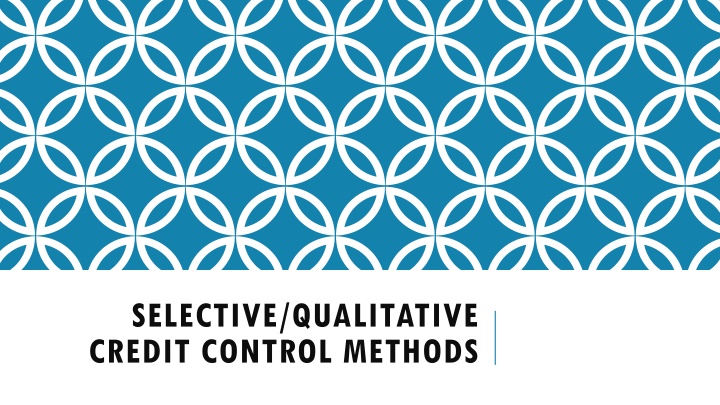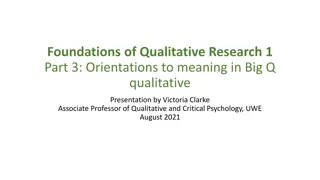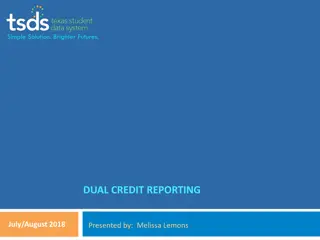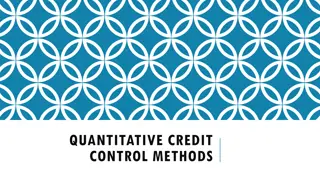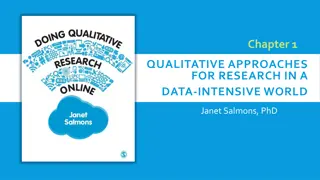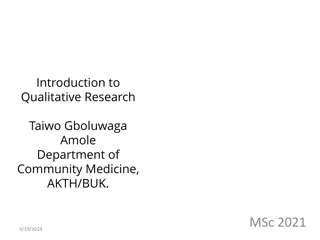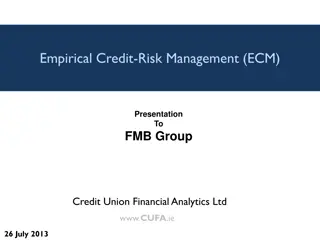Qualitative Credit Control Methods Explained
Selective/Qualitative credit control methods involve regulating the quality and direction of credit flows by implementing controls such as ceilings on credit, margin requirements, discriminatory interest rates, directives, direct action, and moral suasion. These methods are used by central banks like the RBI to influence credit distribution to specific sectors or purposes.
Download Presentation

Please find below an Image/Link to download the presentation.
The content on the website is provided AS IS for your information and personal use only. It may not be sold, licensed, or shared on other websites without obtaining consent from the author.If you encounter any issues during the download, it is possible that the publisher has removed the file from their server.
You are allowed to download the files provided on this website for personal or commercial use, subject to the condition that they are used lawfully. All files are the property of their respective owners.
The content on the website is provided AS IS for your information and personal use only. It may not be sold, licensed, or shared on other websites without obtaining consent from the author.
E N D
Presentation Transcript
SELECTIVE/QUALITATIVE CREDIT CONTROL METHODS
SELECTIVE CONTROL METHODS / QUALITATIVE CREDIT Under Selective Credit Control, credit is provided to selected borrowers for selected purpose, depending upon the use to which the control try to regulate the quality of credit -the direction towards the credit flows. The Selective Controls are:- 1. Ceiling on Credit:- The Ceiling on level of credit restricts the lending capacity of a bank to grant advances against certain controlled securities.
SELECTIVE / QUALITATIVE CREDIT CONTROL METHODS 2. Margin Requirements :- A loan is sanctioned against Collateral Security. Margin means that proportion of the value of security against which loan is not given. Margin against a particular security is reduced or increased in order to encourage or to discourage the flow of credit to a particular sector. It varies from 20% to 80%. For agricultural commodities it is as high as 75%. Higher the margin lesser will be the loan sanctioned.
SELECTIVE / QUALITATIVE CREDIT CONTROL METHODS 3. Discriminatory Interest Rate (DIR):- Through DIR, RBI makes credit flow to certain priority or weaker sectors by charging concessional rates of interest. RBI issues supplementary instructions regarding granting of additional credit against sensitive commodities, issue of guarantees, making advances The RBI issues directives to banks regarding advances. Directives are regarding the purpose for which loans may or may not be given. SM Com etc.
SELECTIVE / QUALITATIVE CREDIT CONTROL METHODS 4. Directives:- The RBI issues directives to banks regarding advances. Directives are regarding the purpose for which loans may or may not be given.
SELECTIVE / QUALITATIVE CREDIT CONTROL METHODS 5. Direct Action:- It is too severe and is therefore rarely followed. It may involve refusal by RBI to rediscount bills or cancellation of license, if the bank has failed to comply with the directives of RBI.
SELECTIVE / QUALITATIVE CREDIT CONTROL METHODS 6. Moral Suasion:- Under Moral Suasion, RBI issues periodical letters to bank to exercise control over credit In general or advances against particular commodities. Periodic discussions are held with authorities of commercial banks in this respect. Monetary policy is a regulatory policy by which the central bank or monetary authority of a country controls the supply of money, availability of bank credit and cost of money, that is, the rate of Interest. Monetary policy/monetary management is regarded as an important tool of economic management in India. RBI controls the supply of money and bank credit. The Central bank has the duty to see that legitimate credit requirements are met and at the same credit is not used for unproductive and speculative purposes. RBI rightly calls its credit policy as one of controlled expansion.
